GERMAN DIPLOMAT IN PARIS SHOT
Paris, France · November 7, 1938
On this date in 1938, 17-year-old Herschel Grynszpan, an unemployed German-born Polish Jew living illegally in the French capital fatally wounded Ernst vom Rath, Third Secretary at the German embassy. He shot Rath, he told authorities, out “of love for my parents and for my people.” His was an act of protest against the Nazi government’s deportation of some 12,000 Polish Jews living in Germany, including members of his family, who were stripped of their property and herded aboard trains to Poland.
Two days after the shooting, which was the fifteenth anniversary of Hitler’s unsuccessful Beer Hall Putsch—the holiest day in the Nazi calendar—Rath died. That night carefully orchestrated anti-Jewish violence “erupted” throughout the Third Reich, which now included post-Anschluss Austria, renamed “Ostmark” after union with Nazi Germany. During Kristallnacht (“Night of Broken Glass”) and for the next 48 hours, Nazi thugs burned or damaged as many as 1,500 synagogues and ransacked and smashed the windows of more than 7,500 businesses, community centers, and homes. Almost one hundred Jews were killed by government estimate (almost certainly low-balled). Also killed were a few gentiles (“Aryans”) mistaken for Jews.
Approximately 20,000–30,000 Jews between the ages of 16 and 60 were hauled off to German concentration camps in the November pogrom. Heaping insult on injury, the Nazi government forced the Jewish community to pay Judenvermoegensabgabe, a collective fine of one billion Reichsmarks for the murder of Rath (equal to roughly 5.5 billion U.S. dollars in today’s currency), which was levied by the compulsory acquisition of 20 percent of all Jewish property. Additionally, the state demanded that Jews sweep up the rioters’ mess and pay the state six million Reichsmarks to cover the cost of insurance claims for property damage.
The murderous rampage of Kristallnacht, followed by the forceful German annexation of Czechoslovakia in March 1939 and the atrocity that swept over Poland later in September, built up a wave of resentment against Nazi Germany throughout the world—a wave that crashed over the U.S. two years later in December 1941. Former Kaiser Wilhelm II, from his exile in Holland, characterized the actions of his countrymen as “gangsterisms,” adding that for the first time ever he was ashamed to be a German.
![]()
Kristallnacht, November 9–10, 1938: Violent Turning Point in Nazi Germany’s Assault on Jews
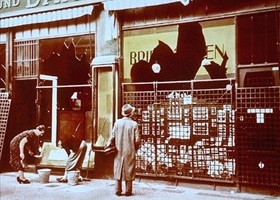 | 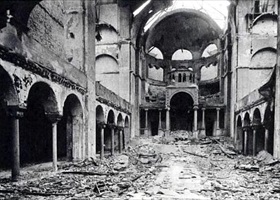 |
Left: Example of damage directed at Jewish businesses during Kristallnacht (literally “crystal night”), a German witticism alluding to the enormous quantity of glass shards, the remains of windows broken throughout the night and next day, mostly in synagogues and Jewish-owned shops. With Kristallnacht the Nazis achieved three of their goals: confiscation of Jewish property by local branches of the Nazi Party to help finance the military buildup to war; increased separation, marginalization, and isolation of German Jews (in certain neighborhoods Jews were required to sell their homes at huge losses and move to other neighborhoods); and most importantly, the move from the anti-Semitic policy of discrimination to one of ethnic cleansing, which continued in the Third Reich and conquered territories until the end of World War II.
![]()
Right: Interior of Berlin’s Fasenenstrasse Synagogue, constructed between 1910 and 1912 in the affluent neighborhood of Charlottenburg off Kurfuerstendamm, after it was set on fire during Kristallnacht on the morning of November 10, 1938 (perhaps not ironically, on Martin Luther’s birthday). In Berlin 9 out of 17 synagogues were torched; in Vienna, the Austrian capital, 95. In all, over 1,000 synagogues were vandalized or destroyed.
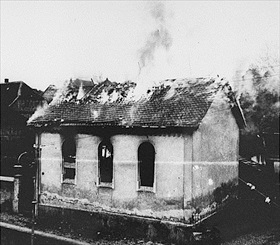 | 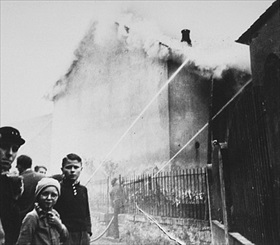 |
Left: Not even the smallest towns in Germany escaped the Nazis’ mayhem and wrath against Jews. In this photograph a small synagogue in Ober Ramstadt (Hessen, Germany), roughly 18 miles south of Frankfurt am Main, burns on Kristallnacht.
![]()
Right: As the Ober Ramstadt synagogue burned, local residents watched firefighters instead save a nearby house. In some German cities such as Cologne police handed out axes and other tools of destruction to troublemakers in the mob, supplying them with lists of names and addresses of Jewish properties for them to destroy. The mobs cut fire hoses when conscientious firefighters directed water onto Jewish properties.
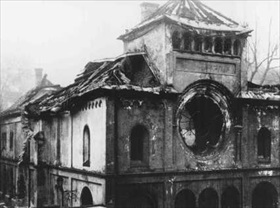 | 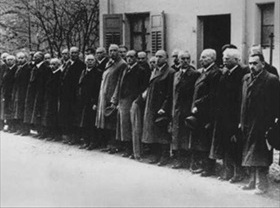 |
Left: Munich’s Herzog Rudolfstrasse synagogue off Maximillianstrasse. By midnight, November 9, 1938, attacks on Jewish businesses, homes, and synagogues were occurring all over Germany and Austria. Mobs roamed streets, shouting, “Beat the Jews to death!” In Munich, the first synagogues started burning at midnight. In Berlin, Kristallnacht was delayed till 2 a.m. on November 10 so that the police would have time to prepare. They identified Jewish properties that would be destroyed and set up roadblocks to keep traffic away from those areas. Police were instructed not to interfere with the rioters.
![]()
Right: As the looting and destruction wound down on November 10, 1938, the arrests began. Jewish men of all ages were rounded up and marched through the streets as some of their German neighbors hurled insults at them. In this photograph Jews arrested after Kristallnacht await deportation to Dachau concentration camp north of Munich. Others were sent to Buchenwald, near the city of Weimar in the German state of Thueringen, and Sachsenhausen, 20 miles north of the German capital, Berlin. The treatment of camp inmates was brutal, but most inmates were released within three months on the condition they leave Germany. In the ten months following Kristallnacht, more than 115,000 Jews emigrated from the Reich. As part of government policy, the Nazis seized houses, shops, and other property the émigrés left behind.
Kristallnacht, November 9–10, 1938: Holocaust Start Date
![]()

 History buffs, there is good news! The Daily Chronicles of World War II is now available as an ebook for $4.99 on Amazon.com. Containing a year’s worth of dated entries from this website, the ebook brings the story of this tumultuous era to life in a compelling, authoritative, and succinct manner. Featuring inventive navigation aids, the ebook enables readers to instantly move forward or backward by month and date to different dated entries. Simple and elegant! Click
History buffs, there is good news! The Daily Chronicles of World War II is now available as an ebook for $4.99 on Amazon.com. Containing a year’s worth of dated entries from this website, the ebook brings the story of this tumultuous era to life in a compelling, authoritative, and succinct manner. Featuring inventive navigation aids, the ebook enables readers to instantly move forward or backward by month and date to different dated entries. Simple and elegant! Click 











